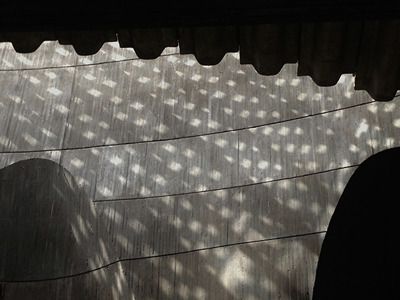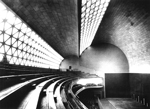You are in: Home page > Magazine Archive > The Structural Conception of space

Orsina Simona Pierini
The Structural Conception of space
Torroja, Fisac, de la Sota

Miguel Fisac, Church Santa Ana Moratalaz
Abstract
Three buildings tell the story of how Spanish architectural culture, with three significant figures in the shape of Torroja, Fisac and De La Sota, focussed on research into modern spatiality through experimentation with structural conceptions on the use and potential of different construction materials.
From the Fronton Recoletos, via Fisac's Hydrographic Institute, to the Gymnasium of the Colegio Maravillas, it is possible to follow the variations and elements of continuity in this search.
“Delimiting and cladding a space, here lies the eternal problem of architecture [...] a veil that is self-supporting over large spaces despite its lightness.”
Let’s take three buildings: the first is the origin of the discourse, the Fronton Recoletos, an experimental work by the engineer Eduardo Torroja, built in Madrid in 1935, the second is a work from Miguel Fisac’s artistic maturity: the Hydrographic Institute, built on the River Manzanares in 1960, while the third is the Gymnasium of the Colegio Maravillas, by Alejandro de la Sota, flanking “La Castellana”.
The Fronton Recoletos, sadly no longer existing, was a building that substantially coincided with the large room used for the game of pelota. The image that emerges from the remaining photographs is of a large space lit from above, with a roof apparently consisting of two vaults in sequence; in reading its structure, we can understand that there are two curved beams, with a totally smooth and featureless inner surface. These are connected together by a system of ribs, built on site, which let light in and provided diffuse illumination of the room from above.
The structure was designed for the building with Secondino Zuazo, an architect working in Madrid in the early twentieth century who contributed to a definition of the architectural and urban appearance of a large part of the Spanish capital, however, it is evident that the Catalan engineer made his mark on the hall, by opting for a structure that is significant in size, but abstract in its nature and language.
In this, as in successive works, Eduardo Torroja did not seek to characterize the architectural space with his engineering skills, but seemingly wished to avoid displaying the structure’s lines of force. In the Fronton Recoletos the search for uniformity of light and space was achieved using a curved beam that did not want to show its innovative structural force, instead, the shell form used seems to have been invented precisely to allow the light to run across the walls without hindrance, while the sole skylight, not load-bearing, alludes to a structural beam in its two-dimensional design.
Philosophy of Structures, is the English name of Eduardo Torroja’s most important treatise, entitled in Spanish Razón y Ser de los tipos estructurales, while in 1957 Danusso and Colonnetti’s Polytechnic published an important essay of his called Forme a Guscio [Shell Structures], where Torroja went back to the theme mentioned in the initial citation, namely, the resistance of curved surfaces, insisting on the designer’s knowledge: “What is needed is a long tenacious effort in the sense of the most intimate reasons for a shape’s resistance.” The Fronton Recoletos was the first of a series of works built that were in line with the theoretical research of the Institution whose name it gave, a place that continues to testify to the importance of its activities and the experimental nature of its research into the structures of European engineering after the Second World War.
But the Fronton Recoletos also reflects a poetic line, research into architectural forms designed to define space, which we might arguably say influenced modern architecture in Spain in the years that followed. In the same years that Torroja was working in Spain, in Italy, Pierluigi Nervi was trying out new construction technologies, strongly influencing coeval architectural research there. Observing the virtuosity of Nervi’s work, it is evident that the idea of architectural unity has been replaced by that of montage, where the single piece is exalted in its repetition, and where the tension of the lines of force is clear evidence of this. Nervi’s own words explain the ultimate sense of his work: “Structures that are part of the static needs and such as to become the visible materialization of the plays of strength occurring inside these.” The two different structural conceptions, one used in the search for continuity and spatial unity, the other designed to bring out the structural lines of force, had strict consequences on the ensuing kinds of architectural education of the respective cultural contexts.
In 1960, Fisac created in Madrid the Hydrographic Institute, whose most significant project issue, the erection of a large uniform nave, serving to contain the river hydraulics models and light them from above, led him to a fresh construction and structure challenge. Miguel Fisac, the centenary of whose birth was celebrated in 2013 along with Alejandro de la Sota and José Antonio Coderch, represents, with Francisco Sáenz de Oíza, the figure of that learned architect and active teacher of the generation of maestros who guided Spain’s current architectural trends.
In particular, in his long career, Fisac refined personal poetics strictly linked to the use of materials: structural brickwork, “bone-beams” or reinforced concrete used as a plastic material, are just the best-known applications to the theme of the architectural mass, as the curved walls of his churches, in brick or concrete, testify.
Torroja’s words “Every material has its own distinct and specific personality, and every shape imposes a different stress phenomenon.” were made concrete by Miguel Fisac in the relationship between material and light, leaving us different approaches to delimit emptiness. From the design of the interlocking bricks used in the Dominicos church, passing via the beams of light of the Hydrographic Institute, to the mass of unclad reinforced concrete of the Church of Santa Ana, Fisac seems to have studied the effect of light on material to bring substance to the architectural space. If in the Hydrographic Institute, the request to light the models evenly led to a solution that preferred uniformity and subtle light, in the case of the small church at Moratalaz, Sant’Anna, the primordial curved material serves to express the work’s dramatic element through a complex shifting spatiality, enhanced by the game of light on its surfaces that accentuates the lines defining its limits, leaving the interior profile less defined.
In this institute, Fisac ends up defining a roofing system created using prefabricated ribs to be tightened once in place, whose section recalls the shape of a bone, because of its hollowness and organic shape. In reality, the ribs’ design was determined by their relationship to the light and its diffusion through the space it was enclosing. The roofing of the nave with its exceptional size, in which what dominates is the horizontality of the series of post-tensioned beams, makes the light flow to accent the diaphanous uniform character; while once again, the daring construction system leaves room to delimit the architectural space, managing to avoid showing its complexity and the difficulties in assembling it.
In those same years, Alejandro de la Sota was using a few decisive lines to trace the section of the Gymnasium of the Colegio Maravillas. Also Alejandro de la Sota, Fisac’s peer, had made material and space his own personal poetics, following a very different process of abstraction, however: his Gymnasium, realized in 1962 in fact works on the structural section as a container of spaces. One particular structural element, the repeated variable section beam, in the upper part of its span finds room for the various classrooms, offering its lower part as roofing for the Gymnasium and as a lighting device. Although it recalls the beams of certain bridges created by the young Torroja, it is clear that in this case the lesson is interpreted not so much as a continuous surface, but as a limit of the different spatial qualities obtained through the balancing of the shapes. The simple pattern of lines drawn by the section explains the entire building.
Although the theme is the same, the roofing of a large space to be lit naturally, and the fact that the designer’s approach, as we said, is more focused on a poetic silence, in favour of a volumetric clarity of space, in reality the character of the three woks is very different: if Torroja worked on space using surface curves, and Fisac hollowed the mass using rib bones and reinforced concrete, de La Sota worked with lines.
We have looked at three examples, among the many interesting ones that 1960s Madrid presents us with, to begin to glimpse research into space, volume, balance, light and materials, in line with Torroja’s idea that: “The best work is the one that is sustained by its own form, and not by the hidden resistance of its material. The latter is always easy, while it is the former that is difficult. In this lies the merit, the fascination of research, and the satisfaction of discovery.”
Orsina Simona Pierini is Associate Professor in Architectural and Urban Composition at the Department of Architecture and Urban Studies of the Polytechnic of Milan.














